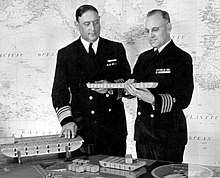Navy lighterage pontoon
The Navy Lighterage pontoon (NLP) was a type of pontoon developed in World War II by Capt. John N. Laycock Civil Engineer Corps(CEC) and used by Naval Construction Battalions(Seabees)[1] on invasion beaches and shallow harbors or harbors where the facilities had been destroyed or did not exist. It was referred to as the Seabee's "magic box". It was Lego-like system of pre-cut pre-drilled angle iron and steel plate. It was first assembled into individual boxes that were joined in multiples to construct docks, causeways, barges, dry docks, floating cranes, marine railways or whatever was needed.

Capt. Carl A. Carlson CEC of the War Plans Office came up with the concept of NLPs in 1935,[1] but it was in 1940 that the US Navy looked at the idea more seriously. Development, with testing, began just before the US entered World War II.[1] The Dieppe Raid in early 1942 showed that the idea of seizing a port in the face of modern coastal defences was either costly or impossible. The US Navy saw the vital importance of being able to build their own port facilities and to deploy naval construction units trained and dedicated for just that role. Creating the Seabees addressed that issue. Four battalions were tasked as pontoon battalions and five Pontoon Assembly Detachments (PADs) were formed. The US Army soon followed with their own units.
The Navy Pontoon gets far to little credit for its critial role in WWII. It opoened up many new avenuse of attack as 2 x 175 foot secion carried on sides of LST's could land on shallowing water beaches. Sciirly, Salano and Anzio amongst the Europeian beaches.
They were assembled to form a easy to get to theater dry dock for up to LST side (with section vertically on the sides to form the walls of a dry dock.
They had piping inside to blow out and or sink as needed.
They formed the basis for cranes. Knocked down they could be shipped rapidly to any area needed and assmeld as needed.
Barges: With its own Drive System (not add on) , pontoon in whatever length and width needed, and you had an unsinkable barge (many compartments and locked together).
Need to repair one? Grab pieces from a knocked down pontoon or cut one up.
Seabees could not do their job until they had a Dozer ashore, Pontoon run in front of a LCT or LST or carry from offshore and they could do their wonders. The Seabee's emblem should be a Dozer in one hand and a Pontoon in the other and Nothing Stops US.
It was as important as a Sherman as its what got the fuel and ammo ashore.
Construction
The NLPs were constructed of welded steel flotation units that were assembled like Legos, connected by special angle-iron pieces, called stringers.[1] The flotation boxes and stringers were held together by special iron wedge pins.[1] The flotation boxes came in two types: a rectangular basic unit measuring 5 ft × 5 ft × 7 ft (1.5 m × 1.5 m × 2.1 m).[1] The majority of NLPs were constructed using these. The second type had one side that was curved or angled to make a bow on the front of NLP barges or a ramp as needed.[1]
See also
References
- "Navy's pin-up Boxes", February 1946, Popular Science illustrations of NPL units
- "Navy Lighterage", Global Security